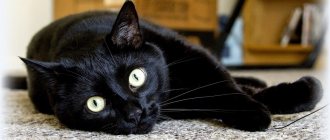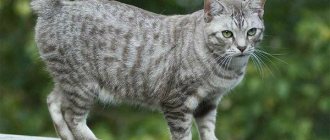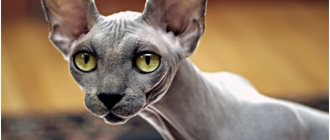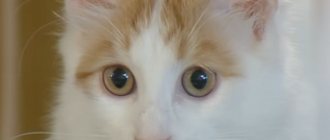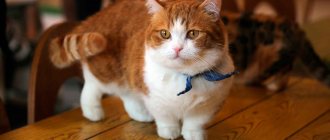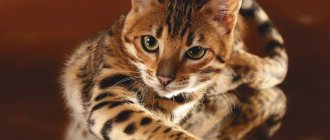What will you learn from the article?
- Tabby cat breeds
- Features of Australian Mist
- American Wirehair
- American Curl
- Asian tabby
- Jungala
- Kurilian, American Bobtail
- Maine Coon
- Manx
- Pixiebob
- Toyger
- Ceylon cat
- Siberian cat
The most common color among domestic cats is dark stripes against a lighter coat. Striping is not a distinctive feature of any breed. Many types of domestic cats can boast tiger stripes on their fur coats.
Features of tabby cats
Tabby is a “wild” coloring that was common among the ancestors of modern cat breeds. The striped color allowed wild cats to camouflage themselves in tall grass while hunting. A mandatory feature of all tabby cats is the pronounced letter “M” on the animal’s forehead.
Tabby cats are believed to have strong immunity. This is not a coincidence, because the streaking gene is directly related to health. It promotes the formation of a strong immune system.
The character of tabby cats is balanced. These are strong, dexterous and energetic animals. They are freedom-loving and independent. These cats are inquisitive and love to be the boss of the house.
Character
First of all, it is important to remember that, despite the fact that all gray-white cats are united by color, they themselves are individual animals that are not similar to each other. Therefore, the character and behavior of one cat may differ significantly from these indicators in another. It is easiest to predict and analyze the character of purebred animals, because they are well researched and studied by scientists. It is much more difficult to judge the character of yard gray-white cats.
Despite this diversity, many owners of gray-white cats still highlight some similar features of these animals. Thus, in terms of their behavioral patterns, such pets are quite calm and docile. Some of them may show increased activity and playfulness, but such characteristics are due to the characteristics of a particular breed.
Gray-white cats are quite friendly towards their owners and household members. At the same time, it is worth considering that such animals can remember the insult for a long time and try to take revenge.
Therefore, you should not show unreasonable aggression and anger towards your pet. In addition, such animals are easy to train and learn; they quickly begin to use the tray and know their place. Such signs are due, first of all, to the high intellectual abilities that nature has endowed gray-white furry pets with.
Varieties
Cat mackerel
- Mackerel cat. The stripes on his back are narrow and continuous, they gently curve. There are dark markings on the paws and near the tail. Dark lines run along the animal's cheeks to the corners of the eyes.
- Spotted tabby cat. In this variety, the stripes are very broken, they are more like spots.
- Classic striped color. There are circulating spots of dark brown, black or gray on the sides. Three narrow stripes stretch along the spine, the central stripe is painted in a darker shade.
Popularity of the red and gray tabby cat
Since ancient times, the red tabby cat was considered a talisman against various diseases and misfortunes. The red coat color symbolizes joy, happiness and wealth. These are cunning, slightly arrogant cats. But their playful nature makes up for these shortcomings. You won't be bored with them.
The gray tabby cat is the hero of many folk tales and songs. Such cats are often used to advertise an active, cheerful pet. They are believed to charge a person with positive energy and bring him good luck.
Let's move directly to the list of the most popular breeds that have striped coloring.
American Bobtail
This breed arose by chance. In the 60s last century, a kitten with an unusually short tail was found. It turned out that this is a manifestation of a dominant gene. It was this baby who became the ancestor of the entire breed.
Most American Bobtails are born with short tails, but there are tabby kittens that are born without a tail at all. True, such individuals are not allowed to exhibit.
These cats have long, strong legs. The head resembles a wedge. The muzzle is wide and has well-defined cheeks. The cat's nose is wide, slightly snub. Adults have tassels on their ears. The coat is dense and fluffy.
The length of the tail does not exceed 8 cm.
American Bobtails are distinguished by their poise and calmness. These cats are very playful and sociable. They are very friendly and get along well with other pets. They can't stand loneliness. They love walks and active games, and love to accompany their owner on trips.
Breeds
There are several breeds of domestic cats whose fur can be colored gray and white. Let's take a closer look at each variety.
Siberian
The appearance of these cats delights many - their thick and fluffy fur, combined with a strong, muscular body, makes an indelible impression. But, despite such a large appearance, these animals are devoted and faithful to their owner, and are also quite gentle, affectionate and loving.
Persian
This cat breed has a squat body structure and a medium-length body. The appearance of the animal is quite attractive, but its character can be obstinate. Persian breed animals need a lot of attention and care. They are quite calm, but can sometimes be overly playful.
British Shorthair
Many British owners note that this breed is ideal for keeping at home. The nature of the animals is quite calm and docile, they are very friendly and make good contact, but at the same time they are undemanding in terms of care and maintenance, and do not require additional comprehensive measures.
As for the anatomical structure, it is important to note that the cats’ muzzle is full-cheeked and has a round shape, the body is strong
Turkish Angora
The Turkish Angora is a breed of cat that is particularly active. Such animals need regular walks in the fresh air. The movements of the animal are distinguished by grace and nobility.
The cat's body has an unusual wedge-shaped shape and small dimensions.
American Curl
This breed is quite unusual and unusual to the eye. The main distinguishing feature of such animals is their curling ears. The American Curl also differs from other breeds in its strong and massive body and well-developed muscles.
Nibelung
These animals are considered descendants of the famous Russian Blue cat. However, if the latter has an exclusively gray color with a blue tint, then Nibelungs may also have white inclusions on their fur (but quite rarely).
This breed is not distinguished by its large size, because the body weight of cats almost never exceeds 5 kilograms. The body itself has a slightly oblong shape, and the muscles of the animal are quite well developed.
This list is not final. In nature, there is a huge variety of purebred and yard cats that are gray and white in color. Our list contains only the most common and popular breeds. Therefore, if at the zoological market you see a gray-white cat of a breed that is not represented on our list, do not think that this is a hoax or a scam.
Cymric
This is another tabby cat with a short tail. The ancestors of this breed come from Maine. They were obtained by crossing a short-tailed cat with a long-haired breed. She is very rare. By the way, the breed is called the Celtic tribe.
The Cymric has a large, rounded head. They have large cheeks and a large chin. The ears are set wide apart and are rounded at the tips. The compact body is well developed. The back of the body is slightly raised (the hind legs of the animal are longer than the front). The tail is missing; in its place there is a small, inconspicuous cartilage.
Cymriki are friendly and playful. The animal does not play pranks: it does not scratch furniture, does not climb curtains, and does not knock over objects. He gets along well with children and never uses his claws. Like the American Bobtail, the Cymric does not tolerate loneliness.
Beloved Basta
Another favorite story about the magnificent letter "M" was told by Jim Willis in his short story "Basta's Beloved," which is included in his book Pieces of My Heart - Writings Inspired by Animals and Nature. It tells the story of an old brown tabby cat named "Mother".
Another frequently cited article states that in ancient Egypt, cats were worshiped as gods and the cat never forgot. Indeed, the goddess Bastet was depicted with a cat's head, and Ra, the sun god, was often depicted as a cat.
It's no surprise that tabby cats are especially worthy of our respect. Today they create their own legends about them and many of you will confirm this.
Norwegian Forest Cat
The name speaks for itself. These cats previously lived in the harsh conditions of the Norwegian forests. There is a version that Angora cats were brought to Scandinavia by the Vikings.
There they were crossed with their short-haired counterparts. The resulting breed acquired a thick undercoat and strong claws. She stood out for her strength, agility and large size.
Pros and cons of a barn cat
Advantages of four-legged strays:
- good health;
- obedient, affectionate character;
- unpretentiousness in food and maintenance;
- high intelligence;
- no difficulties when finding a mating partner.
The main and, perhaps, the only drawback of street cats is their unpredictability of character. Stray cats are careful in expressing their emotions, therefore, when taking such an animal from the street, you cannot be sure that it has a calm, easy-going disposition. Otherwise, mustachioed-striped tramps successfully compete with their purebred brothers.
Source
Pixie bob
Another breed that has a wild disposition. It is the result of crossing a domestic and wild cat. The name of the breed literally translates as “short-tailed elf.”
These cats are quite large - the weight of males reaches 8-10 kg. Interestingly, representatives of the breed have polydactyly - more fingers than necessary.
However, this is not considered a disadvantage. In addition, such individuals are more resilient and have good health. The most common color is black or brown stripes on a light background.
The pixie bob has a massive, pear-shaped head. Due to the growth pattern of the coat, sideburns are observed. The ears are medium in size and have tufts at the tips. The paws are powerful, each paw can have up to 7 toes. The eyes are wide, the brow ridges are well defined.
The length of the tail does not exceed 5 cm. The Pixie Bob is a long-haired breed. The length of the coat can exceed 5 cm.
Like dogs, pixie bobs follow their owners everywhere. They love active games, swimming and walks. They don’t play pranks and don’t impose themselves. They are easy to train. They get sick extremely rarely.
How to care?
Caring for gray-white cats is not much different from caring for animals whose fur has other shades. However, there are still some characteristic features.
So, in the process of keeping an animal, as well as caring for it, one should take into account all the features of the breed that are characteristic of this animal. Particular attention should be paid to the behavioral patterns of cats.
In addition, as a general rule, when eating, you should avoid including animal products rich in iodine in your diet. The thing is that a high content of this component in the animal’s body can affect its appearance in such a way that the gray-white wool will have a brownish tint. If you want to preserve the original purity of the color, then this rule should in no case be neglected.
The diet must be saturated with all microelements and substances that are necessary for the full growth and development of the animal. It doesn’t matter whether you prefer dry food or natural food.
Due to the light color of the coat, grooming measures for it deserve special attention. Gray-white cats need bathing and hygiene procedures more often than other cats. This is especially true for those animals that spend a lot of time outside (for example, if you live in a private house and let your cat out into the yard). Combing procedures are also necessary, the regularity of which depends on the length of the fur of a particular animal.
Of course, to keep a cat at home, it must be provided with all the necessary equipment: a tray that acts as a toilet, its own bed, bowls of food and water, and a scratching post. Try to create the most comfortable and convenient conditions for the cat, because in your apartment he should feel at home, and not as a guest.
Pay close attention to his behavior and mood.
Despite the fact that all of the above aspects of cat care and maintenance are very important, the basic and basic principle of keeping a pet is still constant monitoring of its health. In order to maintain the animal's health at the proper level, from the very first day of keeping him, make sure that he has received all vaccinations and other necessary medical procedures. Do not forget about regular systematic visits to the veterinarian to treat the animal for fleas, worms and other harmful organisms.
Constantly monitor the behavior and activity level of the cat at home, and at the first manifestations of the disease, contact a specialist.
Thus, you and I were able to see that in nature there are a huge number of species and breeds of gray-white cats. Some are more valuable and cost more than others . Despite this, there is no doubt that regardless of breed or lack thereof, the gray and white color attracts many. It is important to remember that the physiological and psychological characteristics of a particular animal will depend more on its breed, and not on its color. Therefore, before buying a pet, carefully study the characteristic features of cats of the exact type you plan to have at home.
About the Siberian breed of gray cats, see the video below.
Striped cats are more popular among pet lovers than their solid-colored relatives. Contrasting horizontal and vertical stripes on the pet's coat, arranged in a chaotic manner, make it look like a small tiger.
This color is called tabby. It is typical for both individual cat breeds and outbred individuals or mixed breeds. Representatives of which cat breeds are more likely than others to be born striped whales?
Soukok
These tabby cats are native to Kenya. There is an opinion that these are ordinary domestic cats brought by Europeans, who escaped into the forest and adapted to life in the tropics.
The cat's head is small and wedge-shaped. At the top the skull is almost flat. The ears are round and wide at the base. There are tassels at the ends.
The eyes are large and almond-shaped. Their legs are long, the hind legs are larger than the front ones. When walking, it seems that the cat is crouching. The tail is also long. The body is muscular. The coat is short and lies close to the body. The weight of cats reaches 3-6 kg.
Tabby color standards
All tabby cats are marked with a special “Scarab mark” - a large letter “M” drawn on their forehead. In ancient times, many peoples considered this mark divine and associated legends and parables with it. And another sign of minke whales is that their eyes are outlined in black.
Black eye rims and the “Scarab mark” are signs of tabby color
The following tabby color variants are known in cats:
- tiger (mackerel);
- classic marble;
- modified marble (marble);
- marble torn;
- marble torn;
- spotted (spotted).
There are six basic tabby color options.
Also, “striping” in cats can appear in combination with other colors:
Paw pads, nose
The standards of different breeds have different requirements for the color of the nose and paw pads of tabby cats. But first of all, they must be in harmony with the basic color tones:
- pink - if white is present;
- beige - for fawn, gold and cream colors;
- gray - with blue, purple and silver tones;
- red - in ginger cats;
- brown - with a predominance of chocolate or dark gold;
- black - in contrasting colors with a lot of black.
The color of the nose should be in harmony with the main color
Eye color
The eye color of tabby cats varies, but it does not depend on the breed, but on the characteristics of the specific color and the saturation of its constituent pigments. So, tabby cats can have the following eyes:
- different - heterochromia occurs not only in white, but also in tabby cats, only it happens much less frequently;
- blue - this eye color is rarely found in minke whales, except perhaps in those whose color contains white and color-points;
- green - common in tabbies with dark pigmentation;
- yellow, from lemon to orange - a very “popular” color;
- brown (nutty) - more common in non-pedigreed individuals.
Cats do not have black eyes; an illusion of this color can only be created due to the dilated pupil.
Photo gallery: eye color in tabby cats
Main color
Although complete democracy reigns in the formation of tabby cat colors, and there are a huge number of possible options, there are also mandatory tabby rules. The main one is: the main background should be lighter and occupy approximately twice the body area than dark markings.
Here are the basic tabby colors:
- grey;
- Ivory;
- gold;
- golden brown;
- silver;
- light blue;
- red.
However, nature and selection create such backgrounds for tabby patterns that sometimes even an artist cannot name their color with precision.
Photo gallery: basic tabby color tones
And nature often jokes, placing funny drawings and even inscriptions on cat skins - this also happens with tabby cats.
Photo gallery: striped curiosities
Video: features of tabby cats
Norwegian Forest Cat
A chic fur coat for a Norwegian forest dog is not a luxury, but a necessity in the northern climate. The thick undercoat, which does not get wet in the snow, warms the cat even in the most severe frosts.
The Norwegian Forest Cat comes from a cold country and has luxurious long hair.
The breed has always been famous for its variety of wild colors, the palette of which is being successfully expanded by breeders. Norwegian tabby kittens are especially highly prized.
Photo gallery: wild colors of the domestic Norwegian
Video: Norwegian Wild Forest Cat
Cymric
The Cymric (Welsh) cat looks like a well-fed rabbit, and its fur is soft, long, and silky. The undercoat is so thick and dense that the awn at the base is raised almost perpendicular to the skin. This type of fur makes contrasting marble stains on a red, gold or silver background, to match which the nose and pads . But the expressive eyes of Cymrics usually have the color of ripe gooseberries.
Cymric received its name in honor of the Celtic tribe that once inhabited the English peninsula of Wales.
The most popular breed colors: red marble and torby - an original combination of tortoiseshell (torty) with elements of tabby, which is found only in cats.
Photo gallery: tabby colors of the Welsh “cat-rabbit”
American Bobtail
The short tail of the American Bobtail is a consequence of a natural mutation. At first, cats of this breed were long-haired, but then bobtails with short hair appeared.
Representatives of the bobtail breed are distinguished by their beauty and excellent health.
Among the variety of American Bobtail colors, tabby variants are one of the most popular. The colors of the eyes, nose and fingertips should match the tones of the striped coat.
Photo gallery: bobtail colors - from light silver to dark gold
Video: energetic hunter with short tail
Pixie bob
The Short-Tailed Pixie Bob is the only breed whose standard welcomes polydactylism. The breed's thick coat can be either short or long.
Despite their wild appearance, these animals are kind and playful.
The cat is very similar to a lynx, and it has a corresponding color - usually spotted, less often - mackerel: a dark pattern on a contrasting background, from sand to gray. The pads are usually black, and the nose is also outlined in black.
Photo gallery: “lynx” pixie-bob clothes
Video: pixie bob - little tail, but a lot of fingers
Maine Coon
The giant Maine Coons are irresistible in striped camouflage - this color is considered natural for the breed and gives a menacing appearance to completely peaceful cats.
According to legend, the Maine Coon is the fruit of love between a cat and a raccoon.
The tail, sides and back are the most brightly colored, where the cat’s fur is thick and long, and on the Maine Coon’s belly the fur is short and light.
Photo gallery: Striped Maine Coons
Video: Maine Coon is a giant among domestic cats
Toyger
The creators of this young designer breed imagined the image of a “toy tiger cub” and succeeded in its selection. The bright tiger appearance is in harmony with the golden character of the handsome toyger. The short coat shines and glosses like satin, the eyes are the color of young emerald, and the nose and fingertips are terracotta.
Toygers love to swim and can chirp like birds
But the pure tiger color was not enough for the breed designers - the standard allows not only mackerel, but also a spotted pattern ranging from light brown to black on various backgrounds: from silver to dark red. An exclusive option is in development: silver stripes on snow-white fur.
Photo gallery: the recognizable image of a “toy tiger cub”
Toyger
These brindle cats were only recently recognized in 2007, but they have long since won their place in the hearts of many cat lovers. The name of the breed consists of two parts: “toy” (toy) and “tiger” (tiger). "Toy Tiger" A very appropriate name!
At the end of the 90s. last century, one breeder from the USA set the task of breeding miniature tigers. And she completely succeeded. The toyger is the result of crossing a Bengal with a tiger-colored cat brought from India.
This is a short-haired breed. Their fur is shiny, very soft and elastic. Their body is medium-sized and muscular. The muzzle is slightly elongated. The ears are set wide apart and rounded. The eyes are bright. The limbs are thick and strong. The tail is long and set low. The weight of cats reaches 10 kg, and females - 6 kg.
Despite their “wild” appearance, these cats are very affectionate, intelligent and loyal. They are distinguished by sociability and curiosity. They lead an active lifestyle. They love water procedures. They are not aggressive and get along well with other pets.
Scottish cat color chart
To determine the color of a cat, you can use a table that presents the international classification of animal colors. A special index, consisting of alphabetic and digital values, provides detailed information about the following characteristics of the pet:
- XXX (three capital letters) – name of the breed;
- xx (two small letters) – the main color of the coloring;
- numbers from 1 to 35 - determine the nature of the color;
- numbers from 51 to 54 – tail length;
- digital values from 61 to 67 – eye color;
- additional numbers from 71 to 73 are the shape of the ears.
The color code is as follows – ХХХ.хх.NN.NN.NN.(NN)
The following abbreviated names are used for Scottish purebred representatives:
- SFS – Scottish Fold (short-haired fold);
- SFL – Highland Fold (long-haired fold);
- SFS 71 – Scottish Straight (short-haired straight);
- SFL 71 – Highland Straight (long-haired straight).
Next in the code are encrypted letters and numbers.
| Designations | Decoding |
| Main color | |
| a | blue |
| b | chocolate, brown, Havana, champagne |
| c | lilac, lavender, platinum |
| d | red |
| e | cream |
| f | tortoiseshell |
| g | blue cream, blue tortoiseshell |
| h | chocolate tortoiseshell |
| j | lilac tortoiseshell |
| n | black, ebony, seal, sable, wild |
| o | sorrel, cinnamon, honey |
| p | yellow-brown, beige |
| q | red-brown tortoiseshell |
| r | beige tortoiseshell |
| s | silver, smoky |
| w | white |
| x | unregistered color |
| y | golden |
| Color character | |
| 1 | van |
| 2 | harlequin |
| 3 | bicolor, two-color |
| 4 | with white markings for color points |
| 9 | white spotting (1-2 cm) |
| 11 | shaded – 1/4 of the top part of the hair is darkened |
| 12 | veiled – 1/8 of the top part of the hair is darkened |
| 21 | striping, agouti factor |
| 22 | marble |
| 23 | mackerel, tiger |
| 24 | spotted |
| 25 | Teked or Abyssinian |
| 31 | Burmese |
| 32 | Tonkinese |
| 33 | Himalayan, Siamese, point |
| 34 | Singaporean |
| 35 | Abyssinian |
| tail length | |
| 51 | tailless pet |
| 52 | for bobtails and menxes 1-2 vertebrae – the rest of the tail |
| 53 | 7-13 cm curled tail (bob tail) |
| 54 | normal/long tail for Manx |
| Eye color | |
| 61 | blue |
| 62 | yellow, orange, golden |
| 63 | disagreement |
| 64 | green |
| 65 | Burmese cat eye color |
| 66 | Tonkinese cat eye color |
| 67 | eye color of Himalayan and Siamese cats |
| Ear shape | |
| 71 | straight ears |
| 72 | twisted back |
| 73 | twisted forward |
Fold-eared and straight-eared cats with long and short hair can have any color - there are more than 50 color options. And if you add to this the cute face and naive look of a Scottish kitten, emotions simply go off the charts.
It is impossible to pass by such a mustachioed, fluffy miracle. But you should remember: no matter what color the chosen pet is, it requires care, care, attention and love.
I like5I don't like
Maine Coon
This breed has probably gained the greatest popularity among all cats around the world. Its homeland is North America, Maine. Only large, hardy animals with thick undercoat and thick fur can survive the cold winters of this area.
The Maine Coon's body is muscular, and the cat itself is large. The head is medium size, square in shape. The ears are large, pointed, wide at the base. Paws of medium length. The tail is long, fluffy, and should reach the level of the shoulder blades. The coat is soft, dense, and there is a collar around the neck (however, not always). The color can be any, including striped.
Their character is soft and affectionate. They become very attached to their owner. They lead an active lifestyle and do not require special attention to themselves. Maine Coons do not like to be held. They prefer to just be next to the owner, watching everything that happens.
Brachycephalic cat breeds
List of brachycephalic breeds:
- British Shorthair;
- Scottish lop-eared;
- Himalayan;
- exotic;
- Persian
Exotic cat
CFA (Cat Fanciers Association) annually publishes a ranking of the most popular breeds. For many years, kittens with flattened faces have been at the top of the rankings, which indicates their popularity.
British Shorthairs with a slightly flat nose
British shorthair cat
The British cat is characterized by a round, plump muzzle, slightly sagging cheeks, and small, neat ears. The animals have a squat, dense body and strong limbs.
In British cats, brachycephalic syndrome manifests itself to the least extent. They are distinguished by a short, wide and straight nose, which forms a vertical line with the chin.
British Shorthair cats are self-sufficient, they tolerate loneliness calmly and do not like noisy companies and active games. They are great for singles who spend a lot of time at work. These animals have a sense of self-esteem, so they expect respect from others.
https://youtube.com/watch?v=XNYtB9Ill8o
Scottish Fold: almost normal profile
Representatives of the Scottish Fold breed have a slightly flattened muzzle, and their profile is close to normal. The calling card of the Scottish Fold is drooping ears and a surprised expression in the eyes. The weight of an adult animal is 4–5 kg, the physique is correct and powerful. The head is round, proportional to the whole body. Hanging ears visually make the head even rounder.
Scottish fold cat
Scots are always loyal to their owners, they are obedient, easy to train, calm, and rarely release their claws. At birth, babies' ears are straight and erect; they droop later. Sometimes this does not happen; such individuals are classified as a related breed, the Scottish Straight.
Some representatives of the breed have thicker tails than normal, which is considered their main and only drawback. Animals with thick tails have too massive hind limbs, which interferes with normal movement.
Luxurious Himalayan cat: Persian face, Siamese color
The Himalayan cat is an amazing, noble animal, a direct descendant of the Persian. The breed was bred artificially by crossing Persian and Siamese cats. The cats inherited the appearance of the Persian and the royal coloring of the Siamese. The breed is officially recognized by only two felinological associations - TICA and CFF.
Himalayan cat
Distinctive features of appearance and physique:
- rich blue eye color;
- color point coat color - dark paws, tail, muzzle and ears, everything else is light;
- long fluffy fur;
- large rounded body and short limbs.
Himalayans have a calm, gentle character. They are similar to Persians, but more active, they love to play and run after toys. They get along well with children as long as they don't cuddle them too much.
Plush big-eyed exotic
The American Shorthair Exotic cat, or Exotic, is an unusual cross between the American Shorthair and the Persian breed. Exotics are surprisingly cute, looking like plush toys. They inherited the anatomical features of the Persians - a flattened muzzle, an upturned nose, neat ears, and large round eyes. Exotics have a dense, squat body and short limbs.
Best articles: Goats turned out to be smarter than we thought
Exotic
These are affectionate, calm, flexible and very playful animals. In adulthood, they remain active and enjoy playing with their owner. Very attached to people. Exotics are quiet, rarely meow and do not bother their owners. They get along well with people and other animals, including dogs.
Unlike Persians, who have long, thick fur, exotics are easy to care for. Caring for plush short fur does not require much effort or time. That is why exotic cats are popularly called Persians for lazy people.
Classic brachycephalic – Persian
The Persian breed is very common in the post-Soviet space. Cats look very large due to their incredibly fluffy fur. These are lazy, clumsy animals that love peace.
Persian cat
Thick coat requires careful and regular care. It is necessary to comb your pet frequently to avoid the formation of mats that will have to be cut off. A well-groomed coat looks gorgeous, but it takes time and patience.
Exterior of a Persian according to the breed standard:
- large body, developed muscles;
- small triangular ears;
- weight of an adult cat – up to 7 kg;
- round head;
- flattened muzzle and upturned nose (at eye level);
- large round eyes yellow or green;
- short limbs.




